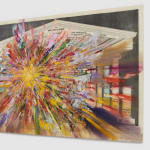-
Artworks
 Photo: Phoebe d'Heurle.
Photo: Phoebe d'Heurle.
 Photo: Phoebe d'Heurle.
Photo: Phoebe d'Heurle.
 Photo: Phoebe d'Heurle.
Photo: Phoebe d'Heurle.
 Photo: Phoebe d'Heurle.
Photo: Phoebe d'Heurle.
 Photo: Phoebe d'Heurle.
Photo: Phoebe d'Heurle.
 Photo: Phoebe d'Heurle.
Photo: Phoebe d'Heurle.
 Photo: Phoebe d'Heurle.
Photo: Phoebe d'Heurle.
 Photo: Phoebe d'Heurle.
Photo: Phoebe d'Heurle.
 Photo: Phoebe d'Heurle.
Photo: Phoebe d'Heurle.
 Photo: Phoebe d'Heurle.
Photo: Phoebe d'Heurle.
 Photo: Phoebe d'Heurle.
Photo: Phoebe d'Heurle.
 Photo: Phoebe d'Heurle.
Photo: Phoebe d'Heurle.
 Photo: Phoebe d'Heurle.
Photo: Phoebe d'Heurle.
 Photo: Phoebe d'Heurle.
Photo: Phoebe d'Heurle.
Untitled (Temple of Time), 2020
Oil and acrylic on printed canvas94 1/2 x 132 3/8 x 1 5/8 in
240 x 336.2 x 4 cmSoldFurther images
-
(View a larger image of thumbnail 1
)

-
(View a larger image of thumbnail 2
)

-
(View a larger image of thumbnail 3
)

-
(View a larger image of thumbnail 4
)

-
(View a larger image of thumbnail 5
)

-
(View a larger image of thumbnail 6
)

-
(View a larger image of thumbnail 7
)

-
(View a larger image of thumbnail 8
)

-
(View a larger image of thumbnail 9
)

-
(View a larger image of thumbnail 10
)

-
(View a larger image of thumbnail 11
)

-
(View a larger image of thumbnail 12
)

-
(View a larger image of thumbnail 13
)

-
(View a larger image of thumbnail 14
)

In this work, Firelei Báez overlays brightly-hued, painterly gesture onto a chronological chart of world history by Emma Willard entitled 'The Temple of Time' (1846). Emma Willard was an American...In this work, Firelei Báez overlays brightly-hued, painterly gesture onto a chronological chart of world history by Emma Willard entitled "The Temple of Time" (1846). Emma Willard was an American women's rights activist dedicated to education, who wrote several textbooks on history and geography throughout her lifetime. In this source document, Willard rendered a new perspective on time in multiple dimensions, exhibiting nations both ethnographically and chronographically in an attempt to render a total history of knowledge in time. Drawing visual cues from science fiction, Báez uses mark-marking as a means of intervening within the map's atypical representation of time—in relation to space, "sovereigns by which the age is chiefly distinguished," and figures of ideological influence. Imploding its composition with a vibrant fissure, Báez further complicates linear and reductive approaches to understanding the past, to generate new possibilities for the future.Exhibitions
Never Done: 100 Years of Women in Politics and Beyond, Tang Teaching Museum at Skidmore College, Saratoga Springs, NY, September 17, 2020 - June 6, 2021
Firelei Báez, ICA Boston, Boston, MA, April 4 – September 2, 2024
Firelei Báez, Vancouver Art Gallery, Vancouver, CA, November 3, 2024 – March 16, 2025
Firelei Báez, Des Moines Art Center, Des Moines, IA, June 14, 2025—September 21 2025 (forthcoming)Literature
Cosmo Whyte, "The Poetics of Opacity," Art Papers, Spring 2021. P15.Publications
Golden, T., Respini, E., Godfrey, M., Acevedo-Yates, C., & Russell, L. (2022). Firelei Báez: To breathe full and free (D. Norr, Ed.). New York, NY: Gregory R. Miller &., pp. 6-7.
-
(View a larger image of thumbnail 1
)













